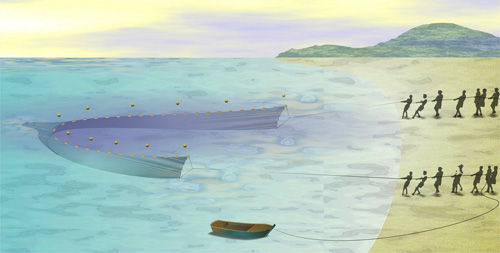How is the EAF-Nansen Programme supporting the work of small projects in its partner countries in Africa?
Artisanal fishers from a fishing community in Avlékéte in Benin wake up every day at dawn to cast the nets in the sea for the next several hours. The nets are often set from shore to encircle a school of fish, but they can also be set at some distance from the more shallow waters. The longer the hauling lines are, the larger the fishing area that can be covered with the seine. Pelagic and demersal species (species that feed and live near the seabed) are the main target.
 Beach seine fishing technique © FAO/FIAO |
Despite seeming like repetitive and mundane daily activity, beach seine fishing constitutes the basis of household income and employment, and accounts for the main source of livelihood and food security in many developing countries. It is an artisanal fishing method vastly used in west Africa. In Benin, for example, beach seines are still the most important fishing gear used by small-scale fishers. The work involves the whole fishing community and often engages the efforts of entire families. Women also hold their share. Not only do they clean, divide, and sell the catches at a nearby market; they also help haul heavy seine nets.
The beach seine fishery is not well-regulated and not well-managed in the Gulf of Guinea today, and has a negative impact on the costal marine resources. On one hand, majority of catches are composed of juvenile fish, which don't bring a lot of income to already poor small-scale fishers; On the other hand, beach seining damages environment, putting at risk sustainability of fish populations and marine habitats, such as nursery and spawning areas. In view of high competition at sea, usually for the same resources and the same fishing areas, fishermen started putting more efforts into increasing the fishing efficiency of the activity. By using smaller mesh sizes, they could catch more fish. However, a high catch of juveniles results in emptying the seas.
This increasingly controversial technique raises a common question on how to address the livelihoods and food security needs of the coastal fishing communities, while maintaining healthy and productive oceans. In recent years, global fishing pressure has significantly increased and beach seining yields part of this responsibility.
Through the work of the EAF-Nansen Programme, developing countries in Africa, collaborating with the Programme, receive technical support for the development of national and regional management plans, using the Ecosystem Approach to Fisheries management (EAF) framework. The Programme currently supports the implementation of EAF management plans for beach seine fisheries in the Gulf of Guinea, (namely in Togo, Benin and Côte d'Ivoire), approved in 2013 by the Fisheries Minister in each of the three countries. So far, actions have been taken by the countries towards the regulation and management of this activity. In Togo, the government has funded net materials to replace them with the proper mesh size, as per recommendations under the management plan. In Côte d'Ivoire and Benin, new laws have entered into force that support the implementation of the management plans. Further steps will be taken in the next years to improve the situation in the entire region.
The EAF-Nansen Programme has also been supporting the implementation of the management plan for artisanal small and medium pelagic fisheries in mainland Tanzania. Artisanal fishing accounts for the main economic activity of the majority of the coastal people in Tanzania and is an important sub-sector of the country's economy. It provides food, income, and employment opportunities. The field project in Tanzania has been operating since the beginning of February 2019 for the period of 18 months, and involves a wide range of various stakeholders, from national fisheries and environment management agencies, local government authorities, research institutions, to fishers and fish workers. Assistance is provided to fill the gaps in the areas related to collecting, monitoring and reporting of key biological, fishery-related social and economic data, monitoring the implementation of the EAF approach in broader terms, and mainstreaming gender equality aspect in the ongoing activities.
The expected long-term impact of the EAF-Nansen Programme is that "sustainable fisheries improve food and nutrition security for people in partner countries." In the long-run, the Programme is also intended to contribute to the achievement of the critical UN Sustainable Development Goals (SDGs) by 2030, esp. SDG14 ("Live below water"), SDG 1 ("no poverty"), SDG 2 ("zero hunger"), and SDG 5 ("gender equality").



